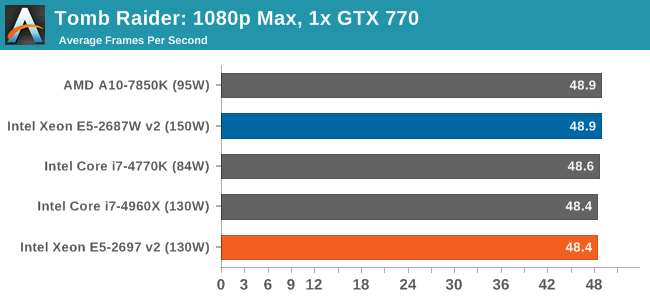Intel Xeon E5-2697 v2 and Xeon E5-2687W v2 Review: 12 and 8 Cores
by Ian Cutress on March 17, 2014 11:59 AM EST- Posted in
- CPUs
- Intel
- Xeon
- Enterprise
For our gaming benchmarks we brought in the MSI X79A-GD45 for some three-way GPU action, as the original GIGABYTE motherboard is limited beyond two GPUs. For the Xeons in our tests, the PCIe arrangement gave x16 in single GPU mode, x16/x16 in dual GPU mode and x16/x16/x8 in tri-GPU mode.
F1 2013
First up is F1 2013 by Codemasters. I am a big Formula 1 fan in my spare time, and nothing makes me happier than carving up the field in a Caterham, waving to the Red Bulls as I drive by (because I play on easy and take shortcuts). F1 2013 uses the EGO Engine, and like other Codemasters games ends up being very playable on old hardware quite easily. In order to beef up the benchmark a bit, we devised the following scenario for the benchmark mode: one lap of Spa-Francorchamps in the heavy wet, the benchmark follows Jenson Button in the McLaren who starts on the grid in 22nd place, with the field made up of 11 Williams cars, 5 Marussia and 5 Caterham in that order. This puts emphasis on the CPU to handle the AI in the wet, and allows for a good amount of overtaking during the automated benchmark. We test at 1920x1080 on Ultra graphical settings for a single GPU, as using multiple GPUs seems to have no scaling effect.

| F1 2013, 1080p Max | ||
| NVIDIA | AMD | |
| Average Frame Rates |
|
|
| Minimum Frame Rates |
|
|
While the higher frequency of the E5-2687W v2 puts it ahead of the 12-core Xeon, in each of our data points, except 3x HD7970, the Core i7-4960X gets the better frame rates.
Bioshock Infinite
Bioshock Infinite was Zero Punctuation’s Game of the Year for 2013, uses the Unreal Engine 3, and is designed to scale with both cores and graphical prowess. We test the benchmark using the Adrenaline benchmark tool and the Xtreme (1920x1080, Maximum) performance setting, noting down the average frame rates and the minimum frame rates.

| Bioshock Infinite, 1080p Max | ||
| NVIDIA | AMD | |
| Average Frame Rates |
|
|
| Minimum Frame Rates |
|
|
Again, the 8-core higher frequency Xeon is faster than the 12-core Xeon in most of our tests, however the i7-4960X beats them most of the time. For certain arrangements, such as 2x HD7970, the Xeons lose slightly to the i7-4770K, most likely due to CPU IPC. However as the difference is only a couple of frames per second out of 130, this should not make much difference.
Tomb Raider
The next benchmark in our test is Tomb Raider. Tomb Raider is an AMD optimized game, lauded for its use of TressFX creating dynamic hair to increase the immersion in game. Tomb Raider uses a modified version of the Crystal Engine, and enjoys raw horsepower. We test the benchmark using the Adrenaline benchmark tool and the Xtreme (1920x1080, Maximum) performance setting, noting down the average frame rates and the minimum frame rates.

| Tomb Raider, 1080p Max | ||
| NVIDIA | AMD | |
| Average Frame Rates |
|
|
| Minimum Frame Rates |
|
|
In all the Tomb Raider tests, all the CPUs perform similarly, making Tomb Raider a seemingly agnostic test to CPU power.













71 Comments
View All Comments
SirKnobsworth - Monday, March 17, 2014 - link
The LGA 2011 i7 chips don't have integrated graphics.Voldenuit - Monday, March 17, 2014 - link
Yeah, the Xeon E3s are great processors for enthusiasts/consumers.I was tossing up between an E3-1230 v3 (2MB more cache) or an i5 4670K (IGP, unlocked multiplier) in my latest build, and ended up with the 4670K because it had a $30 instant rebate, and I wanted quicksync (I know Ganesh says it has inferior transcode quality to x264, but I just need something quick and dirty for my phone, and honestly, I'm seeing more artefacts in the x264 samples he posted than in the QS samples). But it wasn't an easy decision.
Minor nitpick: you can get Xeon E3s with Intel HD graphics. Those are model numbers E3-12x5
http://ark.intel.com/products/family/78581/Intel-X...
mazzy - Monday, March 17, 2014 - link
Even more if you think about the facts that E3 xeons are i7 at i5 price... with ECC and VT tech... ok no OC...MrSpadge - Tuesday, March 18, 2014 - link
I'd take a CPU with IGP any day, unless it costs significantly more. Reason: increased resale value, even if I don't use the IGP myself.CrazyElf - Tuesday, March 18, 2014 - link
"I'd take a CPU with IGP any day, unless it costs significantly more. Reason: increased resale value, even if I don't use the IGP myself."I would not.
Reason is even when you use discrete, it uses additional power. IIRC for Sandy Bridge, a 3.6 GHz Sandy without the IGP switched on uses as much as a 3.4 GHz with the IGP on. Seeing that the graphics have become a bigger emphasis with Haswell, I expect that the IGP will be using a bigger percentage of the total power consumption with time.
austinsguitar - Monday, March 17, 2014 - link
okay...please tell me im not the only one who thinks this article is hilarious! look...if you are going to review two very expensive cpu's, don't test these against normal cpu's. It is shear idiocy to compare these to "desktop cpu's" because they are not....at all. Why can't anandtech do reviews on other affordable xeons and compare them all together. Also funny how they included AMD. That's cutejemima puddle-duck - Monday, March 17, 2014 - link
It's spelt 'sheer'. That aside, your ideas are intriguing to me, and I wish to subscribe to your newsletter.PEJUman - Monday, March 17, 2014 - link
you're the only one who think this article is hilarious.I thought/wished about this dataset previously. What if we simply go to XEONs and trade off clock for cores. i.e. the next logical progression from i7-4960X price bracket. obviously with no control over turbo bins & OC capability, the single thread is hosed. But wondered how many cores near-pro programs can really utilize.
I am just glad we get to see some comparisons. getting more XEON dataset would be interesting but I think it's beyond most of Anandtech reader usage partern.
austinsguitar - Monday, March 17, 2014 - link
You do indeed have a point about consumer cpu's and how they can overclock and are nifty to have for changing multiple options. but...the xeon market for average consumers needs to either be booming or a well kept secret. the 1230v3 is a fantastic cpu and can (for the most part) equal a 4770 for 240 dollars. I know it can not be overclocked, but people (about 70% of the market) do not give a care.But anandtech viewers are overly intelligent arnt we?
MrSpadge - Tuesday, March 18, 2014 - link
Had they not included these regular CPUs people would (rightfully) complain "what do these numbers mean without familiar comparison points?" Comparing 2 products to work out the real-world differences for some specific application is completely different from claiming they'd be equal.